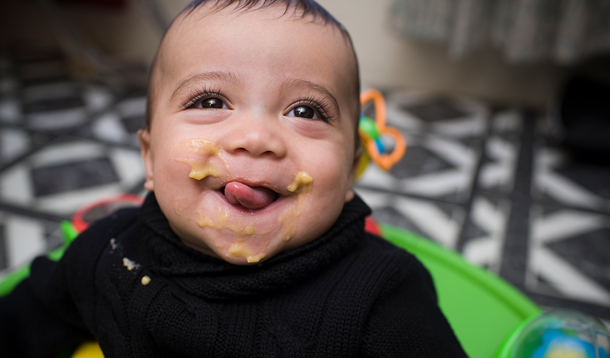
Creating a healthy and safe atmosphere for your baby during meal times is really important for many reasons, but especially to help them establish a healthy relationship with food. Starting solid foods is huge milestone in your little ones life and it should be a fun, no-pressure, relaxed experience for them (and you!).
It is best to feed your baby in a relaxed, distraction-free environment so that baby can focus on his or her food. Have your baby sit in a high chair and make sure that you are sitting approximately at eye level to them. Hold the spoon a few inches in front of baby’s mouth and wait for him or her to open up before you feed- never force them to open their mouths or rush the process. Let your baby be the only guide as to how much or little, and how fast or slow he or she wants to eat. Stop when your baby is not interested anymore—even if that means that he or she only ate 1-2 bites. When you first introduce solid foods (and for the following few months), your baby is getting to know food and becoming comfortable with the concept of eating solids. It's an experimental time, and like any milestone, will likely require lots of patience on your part as the parent. One thing to be aware of is not to hover over your baby during meal times. Imagine if someone hovered over you while you ate—it would probably make you uncomfortable. Even though you may be spoon feeding, take breaks and let your baby explore the food on his own—maybe even play with it. This is one of the ways that baby will become comfortable with food.
Give your baby several chances to warm up to a new food—it may take 15-20 tries before your baby warms up to a food. Do not force feed your baby (even if you feel like your baby hasn't eaten enough)- this may create a negative association with food and he or she may become more resistant to trying new foods. Be cognizant of your baby’s hunger and fullness cues and do not force your baby to eat or over-feed. Notice how YOUR appetite isn't the same everyday- you may be really hungry one day and then not so hungry the next—this is normal for you and baby. Your appetite also changes from meal to meal—as does baby's. Your food intake likely evens out by the end of the week and so will baby's. Babies are VERY intuitive eaters for the most part—they really honour their hunger and fullness cues and will tell you (in more ways than one) when they're hungry and when they've had enough. And remember, until the age of 1, baby's #1 source of nutrition is still breastmilk or formula.
Model healthy eating habits by having at least one family meal per day. Research shows that family meals help foster healthy eating habits and a healthy body image from a very early age through to adulthood. Include your baby in family meals by having his or her highchair right up beside the dinner table and talk to your baby during the meal (even though they are not talking yet). Offer a variety of foods and colors at meal times so that your baby grows accustomed to this. Leave food on your plate if you are comfortably full—try not to instill the "clean your plate" mentality in your baby. Rather, show your baby that it's OK and normal to leave food on your plate if you are satisfied. Even though you may be spoon feeding, take breaks and let your baby explore the food on his own—maybe even play with it. This is one of the ways that baby will become comfortable with food.
Depending on your baby, he or she will warm up to solid foods really fast, or it may take a few weeks (or months) for them to feel comfortable with solids. It's important to be patient and continue to provide a variety of foods in a calm and non-pressured way (even through to toddlerhood and childhood). Some babies progress quickly to finger foods (feeding themselves) and some parents even start with finger foods (a process called Baby Led Weaning). Some babies prefer soft purees for longer than most. It's ok. In any case, let baby lead the way. Regardless of which way you introduce baby to solids, it should be "baby-led." Your responsibility as the parent is to provide a safe, healthy eating environment, age-appropriate nutritious foods and somewhat of a routine. Your baby's responsibility is whether he or she eats, how much, and how fast or slow. Remember, introducing solids should fun and enjoyable for both the baby and the parent. If you are concerned about your baby's weight or food intake, it's important to talk to baby's family doctor who can refer you to a Registered Dietitian.